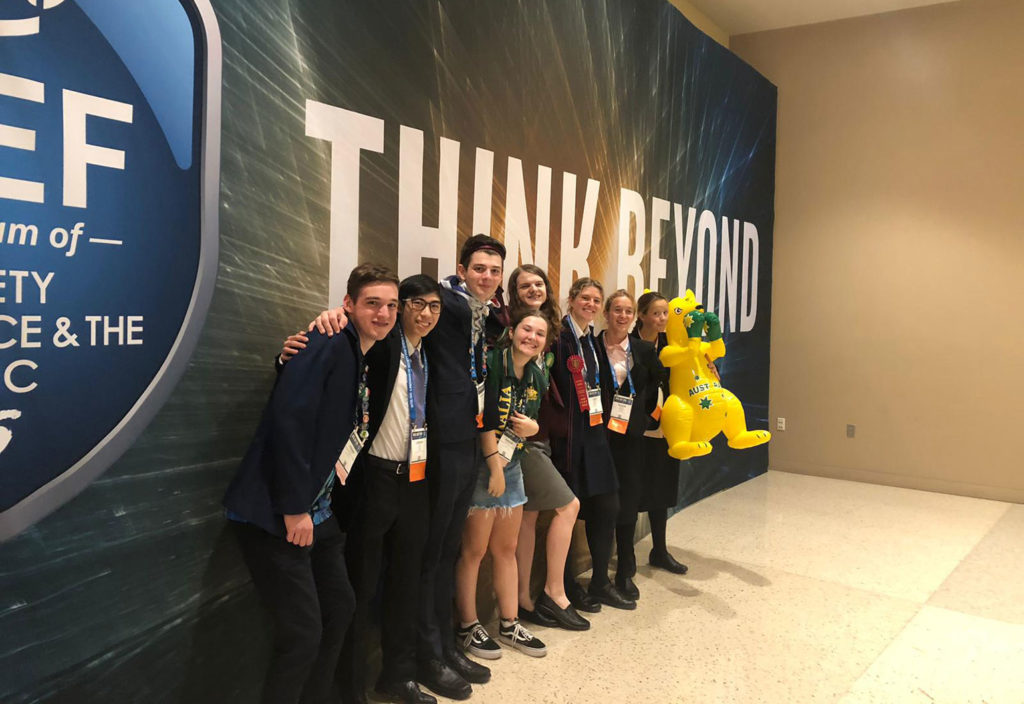Some of Australia’s brightest young innovators have taken home awards at one of the world’s biggest annual student science and engineering fairs.
The recent Intel International Science and Engineering Fair (Intel ISEF), held in Phoenix, Arizona, USA, saw student scientists from Australia compete against 1800 other high schoolers representing 75 countries.
All of Australia’s award winners at Intel ISEF were entrants or finalists in the national 2019 BHP Foundation Science and Engineering Awards, split into two delegations: Australia and NSW.
The stand-out Australian delegate was Lucy Lake from Barker College in NSW, who won second in the Engineering Mechanics category for her project Phase 3. This invention is a high-performance rowing oar that mimics the tubercles on the edge of a whale flipper, reducing the blade’s drag.
Illawarra Grammar School’s Macinley Butson, part of the NSW delegation, won second in the Translational Medical Science category for her design of the SMART System, which reduces tissue injuries during radiotherapy for breast cancer patients.
The invention combines two devices: the SMART Magnetic Array, which deflects electron contamination away from the patient’s skin to the SMART Armour, which absorbs it. The device prevents the patient’s skin from burning and reduces their risk of developing another form of cancer in the future.
Butson has previously been recognised for her inventions and contributions to STEM, including a device that reduces liquid oral medicine wastage and a solar-powered system that turns dirty water into medical-grade sterilised water.
On the podium
The top Intel ISEF prize, the Gorden E. Moore Award, went to 16-year-old US student Krithik Ramesh for his spinal reconstruction aid.
The design uses computer vision and machine learning systems for real-time navigational and surgical assistance during spinal reconstructions.
Ramesh was also awarded the Intel ISEF Biomedical Engineering Award and the ‘Best Of’ award for his invention.
Last year’s “Best of the Best” winner was Australian high school student Oliver Nicholls, who won for his robotic window cleaner. Although it wasn’t an Aussie who scored the top prize this year, CSIRO Education and Outreach Director Mary Mulcahy said in previous years Australian high school students have been recognised for their innovations by Intel ISEF, and was confident Australian students would continue to shine brightly.
“The students in the Australian delegation have all shown outstanding commitment to their projects and it is an incredible achievement to have their work showcased alongside students from around the world,” Mulcahy said.
“I have no doubt we will see great things from all of these students in the years to come.”
Other Australian winners at Intel ISEF from BHP’s finalists were Mosman High School’s Callum Predavec, who placed fourth in the Mathematics category for his Planetary Transfer Calculator, which calculates the distance between any planet, moon or star in the solar system. It is also a web-based application available to anyone interested in outer space.
Tasmania’s Ivy Brain from Launceston College and Mitchell Torok from Rosny College won the Embedded Systems fourth-place award for their creation of aWear, a watch that tracks aged-care residents and monitors their health.
Bishop Druitt College’s Emma Serisier and PLC’s Eliza Martin were entrants in the BHP Awards, who despite not being finalists with BHP, suceeded Intel ISEF award winners. Serisier placed third in the Animal Sciences category for her idea of using chickens as bio-recyclers of household organic waste, and Martin placed fourth in the Biomedical and Health Sciences category for her use of symbiotic formulation to treat lactose intolerance.
BHP Foundation Chief Executive James Ensor said improving science, technology, engineering and maths outcomes for passionate young people was at the heart of the company’s commitment to supporting innovative STEM programs in Australia.
“We know there’s a clear link between science, technology, engineering and math and our future prosperity, so we’re delighted to see this next generation of talented Australians recognised for their passion and commitment to solving some of the world’s big challenges,” he said.
The full list of Intel ISEF winners can be found here.
